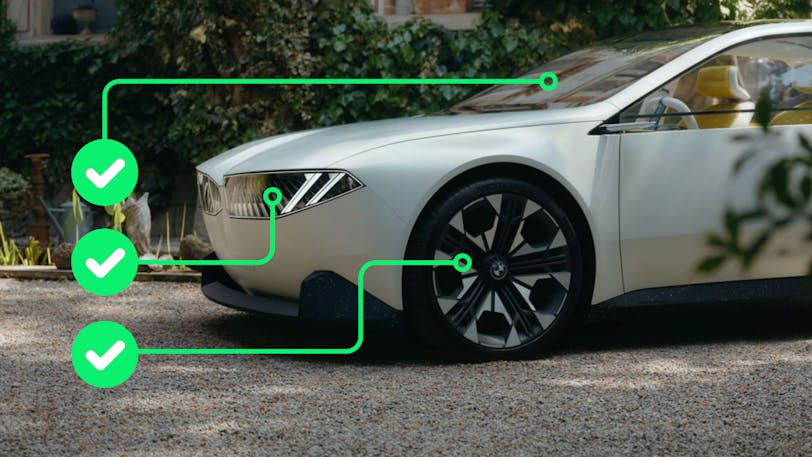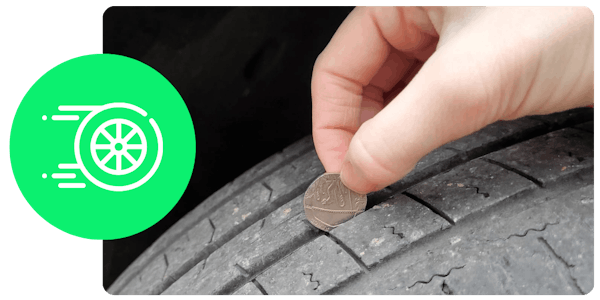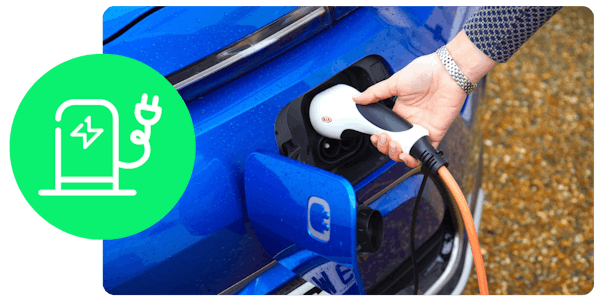EV safety checks
Regular maintenance checks to keep your electric vehicle in tip-top condition

Carrying out some simple safety checks each month (or before a long journey) will help ensure your vehicle is safe to drive. Maintaining a roadworthy vehicle not only keeps you safe but can also be a time and cost-effective measure in the long run

Tyre pressure
Driving with underinflated or overinflated tyres can adversely affect your braking distance, steering, fuel efficiency and the lifetime of your tyres

Tyre tread
Each of your tyres must have a minimum tread depth of 1.6mm. This is a legal requirement

Charge
Plan ahead and consider your next journey when plugging in, and top up accordingly

Lights
Your lights are crucial for you to see and signal with - but they’re also designed so other road users can understand and react to your movements

Screen wash
For optimum visibility keep your screen wash topped up so you can clear any debris or dirt off your windscreen

Tyre pressure
CHECK MONTHLY
A 2017 study from AA Tyres found one in four drivers could be posing a serious risk to themselves and others by heading out on potentially underinflated tyres
The study found an estimated 8.1 million UK drivers haven’t checked their tyre pressures in the last two months – meaning that a large proportion could be driving around on tyres that impede their braking distance, fuel (or range) efficiency, steering and even the tyre’s lifespan
How to check your tyre pressure:
- At most fuel and service stations, there's an air pump for checking and inflating tyre pressures
- Recommended tyre pressures vary -locate the recommended pressure for your vehicle on the driver's door or in the manual
- Set the air pump to the recommended tyre pressure
- Remove the valve caps on each of your tyres (put them in your pocket so you don’t lose them!). Attach the air pressure gauge to the tyre valve - you’ll hear a little ‘hiss’ as it connects, then the machine will give you a reading
- If the tyre pressure reading is lower than recommended, inflate; if high, release some air

Tyre tread
CHECK MONTHLY
Overly worn tyres can affect the handling of your vehicle and contribute to poor cornering and greater stopping distances
If you are stopped by the police and found with illegal tyres you could receive a £2,500 fine and 3 penalty points per tyre
How to check your tyre tread:
- All vehicle tyres are legally required to have a minimum tread depth of 1.6mm
- An easy way to check your tyre tread is to put a 20p coin into the main grooves of the tread
- If the raised outer rim (with "TWENTY PENCE" engraved) is not visible, the tread is sufficient
- Check at least three spots on each tyre, as wear may vary
- Additionally, inspect tyre walls for cuts, tears, bulges, or any damage

Charge
CHECK DAILY
It’s possible to run out of charge (just as it’s possible to run out of petrol or diesel). so, before you set off, plan your route and identify opportunities to take a break or recharge your vehicle along the way if needed
In some situations you can be issued with a Fixed Penalty Notice if your breakdown was foreseeable, such as running out of charge
Charging tips:
- Check your charge gauge regularly and keep in mind your upcoming travel plans so you plug in when needed
- If you charge at home remember to plug-in when you arrive home if you need to top-up
- Have a back up plan to charge at a local rapid, or ultra-rapid charger if you do forget to charge overnight (it happens to the best of us)
- If you’re taking a longer journey or travelling somewhere new be proactive and plan ahead for places to stop and charge on your route, this can give you peace of mind and the charge miles you need to complete your journey stress-free

Lights
CHECK MONTHLY
If your vehicle’s lights are not working, you are putting yourself and other drivers at risk
Light malfunctions can also be a reason your vehicle to fails its MOT
How to check your lights:
- When checking your lights, ask a friend to help you, or park your vehicle near a reflective surface (e.g. a window or garage door)
- One at a time, turn on your indicators, hazard lights, headlights and fog lights to check they’re working
- Next, press the brake pedal to check your brake lights, and finally select reverse to ensure your reversing lights are working too

Screen wash
CHECK FORTNIGHTLY
Keep your screen wash reservoir topped up. It’s important to be able to clear your screen of any dirt so you can have guaranteed clear visibility on your travels
How to top up your screen wash:
- Open your bonnet and find the screen wash reservoir, the cap is often yellow or brightly coloured and will be labelled with the screen wash symbol
- It could be tricky to see the fluid level, but this reservoir can be filled right to the the top so don’t worry about overfilling
- Top up your levels using a mixture of water and screen wash detergent (check the screen wash bottle’s instructions to get the correct mix)
- After you’ve topped up secure the screen wash reservoir cap, and take a minute to check your wiper blades are clean and not worn or damaged

Winter driving tip
Increasing the concentration of screen wash solution in your mix helps prevent your screen wash freezing during the winter months. Typically, brands advise a winter ratio of 50% screen wash to 50% water
Version: DriveElectric - EV Safety Checks 20240124